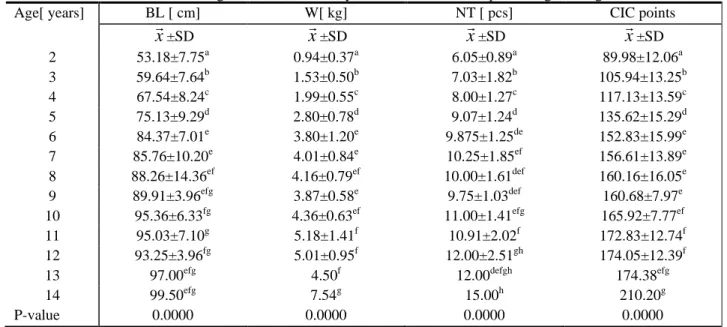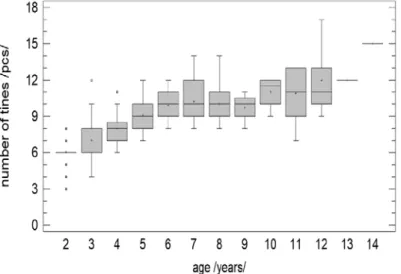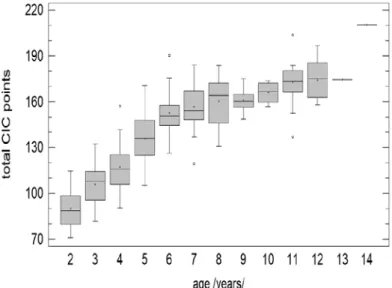70
Evaluation of European Red Deer (Cervus elaphus
hippelaphus
) antlers traits in district of Čadca
Peter Šmehýl
1*, Jozef Hlavatý, Jaroslav Slamečka
21
Slovak University of Agriculture, Faculty of Agrobiology and Food Resources,Department of Poultry Science and Small Farm Animals, Nitra, Slovak Republic
2
Research Institute of Animal Production-National Agriculture and Food Centre, Slovak Republic
Abstract
The paper abstract will be written with Times New Roman 10 pt., justify. It will contain maximum 200 words. A concise and factual abstract is required. The abstract should state briefly the purpose of the research, the principal results and major conclusions. An abstract is often presented separately from the article, so it must be able to stand alone. For this reason, references should be avoided, but if essential, then cite the author(s) and year(s). Also, non-standard or uncommon abbreviations should be avoided, but if essential they must be defined at their first mention in the abstract itself.
Keywords: Provide a maximum of 6 keywords, with a font of TNR 10, in alphabetical order, separated by commas. These keywords will be used for indexing purposes.
1. Introduction
The red deer antlers represent one of the most impressive examples of a sexually selected weaponry trait in mammals and are regrown annually. In red deer, males use antlers during the rutting season in fights with other males in order to defend harems of females, and thus gain paternities [1]. Antlers of Cervidae family are an example of fast growing tissue and the only organs of the mammals capable of complete regeneration [2]
.
Antlers are a secondary sexual characteristic that develop from structures on the frontal bone called pedicles. Pedicles develop in the first year of life, around 4–8 months of age, under the influence of testosterone and, once mature, support the subsequent growth of first antlers [3]. The first antlers reach usually the shape of spiker [4]. Antler growth from the tip of the pedicles occurs quite rapidly between 6 and* Corresponding author Peter Šmehýl
Tel: + 421 37 6414706, Email: p.smehyl@gmail.com
71 positively the length of the 1st antlers, so the large body size is an important criterion to develop the trophy quality of a population [17]. An expressive influence of climatic condition on stag antlers production was proved in red deer stags older five years. The mild winters caused increasing of some antlers traits (number of tines, antlers weight and main beam length) measures in following antler cycle. Genetic information influences the antlers trait as well [2]. Heritability estimates of between 0.43 and 0.85 for velvet antler weight of 2 – 8 year old farmed red deer stags in New Zealand was reported [18], and heritability estimates of 0.47– 0.70 were reported by [19] for 18-month-old white-tailed deer hard first antler main beam length in the USA. Each year the antlers are discarded and each year the new set of antlers are grown. This is called a cycle of antlers growth and it is closely associated with the reproductive cycle, hormonal processes, climate and hydrological factors [2, 15]. Antler growth phenology became earlier and antler mass became greater with increasing age, until approximately 8 years old, after which point there was a marked flattening in the level of antler development [1, 14]. Some antler traits start to decline at 10 year of age [14]. The number of tines increases up to 14 years of stag´s age and the trophy quality depends on the age of stag [20]. The main beam length as a most important trophy trait increased up to 14 year of age, with the highest intensity of growth up to the 6th – 9th year of age [14]. Each antler trait of trophy quality partakes different rate on antler shape and total point score and that way influences the morphometric attributes of stag´s antlers [21]. The beam length is considered to be the most important trophy quality measure [22]. The peak of trophy quality reach the red deer stags in the age of 11–12 years [23, 24].
2. Materials and methods
Analysed territory characteristics
District of Čadca belongs to the region of Kysuce that extends on the west-northern part of Slovak republic. District presents area of 760.62 square kilometres. The forest ratio is quite high and
reaches more than 57 % of the territory. The red deer presents stabile part of hunting management with normative density of 764 animals and average year harvesting 200 stags from about 660 animals hunted. It means that the population density is very high.
Animals analysed
European red deer stags (Cervus elaphus hippelaphus) hunted in the age from 2 to 14 years were included to analyses. Altogether 242 red deer stag antlers were analysed in the study.
Data collection
242 of thoroughly filled trophy evaluation forms for red deer antlers measuring as the official paper of CIC evaluation of the hunting trophies were used as a base for data collection. The population was divided in groups according to the age of the animals. The age was determined as the expert estimate according to tooth abrasion. The length of main beam - BM, weight of the dry antlers (after scull weight deduction)-W, number of tines– NT and total points score–CIC were analysed in the study.
Data analyses
Statgraphics Centurion programme was use for data analyses. Descriptive statistics were calculated for each group and age. F-test (ANOVA) was used to determine the significance of differences between each monitored age.
3. Results and discussion
The results of trophy quality main trait analysis are presented in table 1. The most expressive trophy traits are the beam length, weight of the antlers and number of tines. The total trophy quality is expressed by total point score count by CIC method of trophy evaluation.
Main beam length
72
Table 1. Average values±SD of analysed traits in relationship to the age of stags
Age[ years] BL [ cm] W[ kg] NT [ pcs] CIC points
x
±SDx
±SDx
±SDx
±SD2 53.18±7.75a 0.94±0.37a 6.05±0.89a 89.98±12.06a
3 59.64±7.64b 1.53±0.50b 7.03±1.82b 105.94±13.25b
4 67.54±8.24c 1.99±0.55c 8.00±1.27c 117.13±13.59c
5 75.13±9.29d 2.80±0.78d 9.07±1.24d 135.62±15.29d
6 84.37±7.01e 3.80±1.20e 9.875±1.25de 152.83±15.99e
7 85.76±10.20e 4.01±0.84e 10.25±1.85ef 156.61±13.89e
8 88.26±14.36ef 4.16±0.79ef 10.00±1.61def 160.16±16.05e
9 89.91±3.96efg 3.87±0.58e 9.75±1.03def 160.68±7.97e
10 95.36±6.33fg 4.36±0.63ef 11.00±1.41efg 165.92±7.77ef
11 95.03±7.10g 5.18±1.41f 10.91±2.02f 172.83±12.74f
12 93.25±3.96fg 5.01±0.95f 12.00±2.51gh 174.05±12.39f
13 97.00efg 4.50f 12.00defgh 174.38efg
14 99.50efg 7.54g 15.00h 210.20g
P-value 0.0000 0.0000 0.0000 0.0000
Means values with different letters, in the same column, showed a statistical significance of P≤0.05
Figure 1. The dependence of main beam length on the age of the stags
The beam length monitored in different age of stags varied from 53.18 to 99.50 cm in two y. o. and 14 y. o. respectively. Large scales of values were determined due to the long lived characteristic of red deer. The longest beams were determined in the age of 14 years, so we can note that the beam length keeps it´s raising tendency during all analysed age of stags. The highest intensity of beam rising is visible until the 6th to the 9th year after which a flattening of increase is marked. Our results are in accordance with the results of [14] that presented the same findings.
The deceleration of grow intensity was determined at 10 years as similar as [14] find out too.
Weight of the antlers
73 between analysed groups. The highest growth rate was determined until the 7th year after that only a slight increasing of weight occurred however the weight is rising still up to the 14th year of the age. Though the dependence of antler weight on the age of stags is proved [9, 12], we obtain the
increasing of antlers weight up to the 14th year. The lowest weight was obtained in young animals 0.94 kg was the average value of 2 y. o. stags, average weights of red deer stags older 7 years shows some variability but no tendency of decreasing was determined.
Figure 2. The dependence of antlers weight on the age of the stags
Number of tines
Analyse of tines number is shown in Table 1. As the typical antler shape of two years old stag is the six-pointer [4, 11], we obtain the same average number of tines of two years old animals of 6.05 tines. The number of tines increased according to age rapidly up to the 6th year and after that age a variability of values occurred. However from the
point of view of all ages analysed, the average number of tines increased with different intensity up to the 14th year of age. Our findings are in accordance with the results of [20] that find out the same results.
The highest value of tine number (15 tines) was obtained in 14 years old stags though only one stag was detected in this age.
74
Total points score
The total points score according to CIC trophy measuring methods is considered to be the expression of trophy quality of the population. The individual of 10 years of age is considered to be the mature stag according to CIC rules [25]. The antlers growth is shown in the Figure 4. The table as such as the Figure 4 shows close
correlation of the antlers grow and the age. The lowest value of total points score was detected in 2 years old stags and the highest in 15 years old stags, 89.98 and 210.20 CIC points respectively. The highest intensity of growth was determined up to the 7th year after which a deceleration is expressed.
Figure 4. The dependence of total CIC points score on the age of stags
The highest intensity of antler growth was detected up to the 8th year [1, 14]. The trophy culmination is in the 11th – 12th year of stag´s age [23, 24]. The Slovak legislation [26] notes that the trophy culmination of red deer stag is in the age of 11 years and the stag of 11 years of age is able to hunt, without respect of selection criteria. Our results show that the trophy quality of red deer stags as like as each antler trait values influencing the trophy quality analysed in region of Čadca increased slightly also after the 11th year of stags age that confutes previous results. The same results were proved also in different regions of Slovakia [27, 28]. Our study as same as results of other authors [20, 27, 28] show that the culmination of red deer stag trophy can occur in later age like 11 years, nevertheless the antlers traits and trophy quality is individual trait depending on genetics and a large scale of external factors.
4. Conclusions
75 Acknowledgements
This study was financially supported by the VEGA grant, Ministry of Education, Science, Research and Sport of the Slovak Republic No. 1/0511/15.
References
1. Clements, M., N., Clutton-Brock, T., H. Albon, S., T. Pemberton, J., M., Kruuk, L., E., B. 2010, Getting the timing right: antler growth phenology and sexual selection in a wild red deer population, Oecologia, 2010, 164, 357–368.
2. Degmečić, D., Florijančić, T.,The impact of climate and hydrological factors in development of red deer (Cervus elaphus, L.) antlers in Croatian part of Baranja Danube region. Šumarski list, 2014, 9–10, pp 451–461. 3. Suttie, J., M., Kay, R., N., B., The Influence of Nutrition and Photoperiod on the Growth of Antlers of Young Red Deer. Antler Development in Cervidae, Brown R. D. (Editor), 1983, 61–71.
4. Jaczewski, Z., Poroże jeleniowatych. Warszawa 1981.
5. Li, C., Y., Suttie, J., M., Clark, D., E. Morphological observation of antler regeneration in red deer (Cervus elaphus). Journal of Morphology, 2004, 262, 731–740. 6. Goss, R., Deer antlers, regeneration, evolution and function, Academic Press, New York, 1983.
7. Lincoln, G., A.. Biology of antlers. Journal of Zoology, 1992, 226, 517–528
8. Goss, R., J., Inhibition of growth and shedding of antlers by sex hormones, Nature. 1968, 220, 83–85. 9. Kruuk, L., E., B., Slate, J., Pemberton, J., M., Brotherstone, S., Guinness, F., Clutton-Brock, T., Antler size in red deer: heritability and selection but no evolution, Evolution, 2002, 56, 1683–1695.
10. Bartos, L., Bahbouh, R.. Antler size and fluctuating asymmetry in red deer (Cervus elaphus) stags and probability of becoming a harem holder in rut, Biological Journal of the Linnean Society, 2006, 87, 59–68.
11. Clutton-Brock, T., H., The functions of antlers, Behaviour 1982, 79, 108–124.
12. Mysterud, A., Meisingset, E., Langvatn, R., Yoccoz, N., G., Stenseth, N., C., Climate-dependent allocation of resources to secondary sexual traits in red deer, Oikos Journal, 2005, 111, 245–252.
13. Schmidt, K., T., Stien, A., Albon, S., D., Guinness, F., E., Antler length of yearling red deer is determined by population density, weather and early life-history, Oecologia, 2001, 127, 191–197.
14. Ludwig, J., Vocke, G., Die Vereinfachung einer Wachstumsfunktion, dargestellt am Rothirschgeweih. Zeitschrift für Jagdwissenschaft, 1990, 36, 119–225. 15. Clutton-Brock, T., H, Guinness, F., E, Albon, S., D. Red deer: behaviour and ecology of two sexes, University of Chicago Press, Chicago, 1982.
16. Watson, A.. Climate and the antler-shedding and performance of red deer in North-East Scotland. Journal of Applied Ecology, 1971, 8, 53–67.
17. Ward, F., Asher, G. W., Archer, J. A., Nicoll, G., B., Dodds, K., G., Cox, N., R., Genetic effects on first antler growth in relation to live-weight of red deer farmed in New Zealand., Journal of Livestock Science, 2014, 167, 92–99.
18. Van den Berg, G., Garrick, D., Inheritance of adult velvet antler weights and live weights in farmed red deer, Livestock Production Science, 1997, 49, 287– 295.
19. Williams, J. D., Krueger, W., Harmel, D. H., Heritabilities for antler characteristics and body weight in yearling white-tailed deer. Heredity, 1994, 73, 78– 83.
20. Azorit, C., Anala, M., Carrasco, R. Muñoz–Cobo, J., Influence of age and environment on antler traits in Spain red deer (Cervus elaphus hispanicus). Zeitschrift für Jagdwissenschaft, September 2002, 48(3), 137–144.
21. Stachowiak I., Wycena trofeów łowieckich.
Warszawa. Łowiec Polski, 1994.
22. Zalewski D., Wpływ cech poroża na jakość osobniczą jelenia szlachetnego (Cervus elaphus L.), Sylwan, 2008, 9, 51−59.
23. Zalewski D., Szczepański W., Wzrost i rozwój
morfologicznych cech poroża jelenia szlachetnego
(Cervus elaphus L.) na Warmii i Mazurach. Sylwan,
2004a, 7, 37−45.
24. Zalewski D., Szczepański W.. Udział
poszczególnych cech poroża jelenia szlachetnego
(Cervus elaphus L.) w jego wycenie CIC. Sylwan,
2004b, 10, 30−37.
25. CIC. 2014. Evaluation and Measurement of Hunting Trophies. Budakeszi, 2014.
26. Regulation no 344/2009 that operates the low of game management, in version 125/2012 in version 489/2013.
27. Sabolčík, J., Analýza vybraných parametrov
trofejovej kvality jelenej zveri vokrese Svidník. Ing. Thesis. SPU Nitra, 2017.


